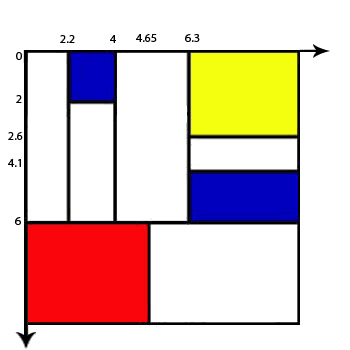PROG0489 - Mondrian
Pieter Cornelis (Piet) Mondriaan (Amersfoort, March 7, 1872 – New York, February 1, 1944) was a Dutch painter and art theoretician, who lived and worked abroad at a later age. Mondriaan is generally seen as a pioneer of abstract and non-figurative art. Especially his later geometric-abstract work — with its characteristic white ground upon which was painted a grid of vertical and horizontal black lines and the three primary colors — is world famous and serves as a source of inspiration for many architects and designers of applied art. He was an important contributors to the De Stijl art movement and he evolved a non-representational form which he termed New Plastic or neoplasticism. Between his 1905 painting The River Amstel and his 1907 Amaryllis, Mondriaan changed the spelling of his signature from Mondriaan to Mondrian.
Input
The input consists of two numbers $x, y \in \mathbb{R}$ ($0 \leq x, y \leq 10$), each on a separate line. These numbers represent the $(x, y)$-coordinate of a point on the painting by Piet Monderiaan that is displayed in the introduction. The painting is made up of a number of non-overlapping rectangles, having sides that are parallel to the $X$-axis and the $Y$-axis. The $X$-axis points from left to right, and the $Y$-axis from bottom to top. The coordinates of the sides of the rectangles are indicated on both axes. You may assume that the given $(x, y)$-coordinate is never located on the border of a rectangle in the painting.
Output
The output contains the color of the rectangle that contains the given $(x, y)$-coordinate: blue, yellow, red of white.
Example
Input:
3.5 1.2
Ouptut:
blue
Pieter Cornelis (Piet) Mondriaan (Amersfoort, 7 maart 1872 – New York, 1 februari 1944) was een Nederlandse kunstschilder en kunsttheoreticus, die op latere leeftijd in het buitenland woonde en werkte. Mondriaan wordt algemeen gezien als een pionier van de abstracte en non-figuratieve kunst. Vooral zijn latere geometrisch-abstracte werk, met de kenmerkende horizontale en verticale zwarte lijnen en primaire kleuren, is wereldberoemd en dient als inspiratiebron voor vele architecten en ontwerpers van toegepaste kunst. Hij was één van de belangrijkste medewerkers van het tijdschrift De Stijl en ontwikkelde een eigen kunsttheorie, die hij Nieuwe Beelding of neoplasticisme noemde. Hij was in het buitenland beter bekend als Mondrian, een wijziging die hij zelf invoerde nadat hij in Parijs was gaan wonen.
Invoer
De invoer bestaat uit twee getallen $x, y \in \mathbb{R}$ ($0 \leq x, y \leq 10$) die elk op een afzonderlijke regel staan. Deze getallen stellen de $(x, y)$-coördinaat voor van een punt op het schilderij van Piet Mondriaan dat in de inleiding wordt weergegeven. Het schilderij is opgebouwd uit een aantal niet-overlappende rechthoeken, waarvan de zijden evenwijdig zijn met de $X$-as en de $Y$-as. Hierbij loopt de $X$-as van links naar rechts, en de $Y$-as van beneden naar boven. Op de assen worden de coördinaten van de zijden van al deze rechthoeken aangegeven. Je mag ervan uitgaan dat de gegeven $(x, y)$-coördinaat nooit op de rand van een rechthoek in het schilderij ligt.
Uitvoer
De uitvoer bevat de kleur van de rechthoek waarin de gegeven $(x, y)$-coördinaat ligt: blauw, geel, rood of wit.
Voorbeeld
Invoer:
3.5 1.2
Uitvoer:
blauw
| Added by: | Peter Dawyndt |
| Date: | 2014-08-29 |
| Time limit: | 10s |
| Source limit: | 50000B |
| Memory limit: | 1536MB |
| Cluster: | Cube (Intel G860) |
| Languages: | PY_NBC |
| Resource: | None |


 RSS
RSS